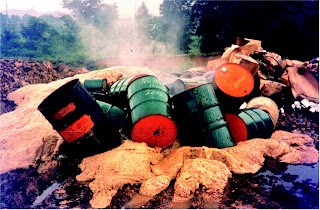Draining the Swamp: The Fed’s Tri Party Repo Machine
Courtesy of Jesse’s Café Américain
 In this case as outlined by the New York Fed memo below, a triparty repo transaction is a transaction among three parties: a cash lender acting on behalf of all holders of dollars (the Fed), a borrower that will provide collateral (dodgy debt holder in shaky financial condition), and a clearing bank, most likely a primary dealer like J.P. Morgan, which is only too happy to collect its fees as an agent of the Fed.
In this case as outlined by the New York Fed memo below, a triparty repo transaction is a transaction among three parties: a cash lender acting on behalf of all holders of dollars (the Fed), a borrower that will provide collateral (dodgy debt holder in shaky financial condition), and a clearing bank, most likely a primary dealer like J.P. Morgan, which is only too happy to collect its fees as an agent of the Fed.
The triparty clearing bank provides custody (agency) accounts for parties to the repo deal and collateral management services. These services include ensuring that pledged collateral meets the cash lenders’ requirements, pricing collateral, ensuring collateral sufficiency, and moving cash and collateral between the parties’ accounts. What if any liabilities the clearing bank such as J.P.Morgan or Goldman Sachs might obtain for the mispricing of risk remain undisclosed, but are probably negligible at worst.
This is the method of obtaining toxic assets from the books of non-primary dealers, and providing stability and liquidity from the aggregate value of all dollar holders to cover the misdeeds of diverse financial institutions and other favored parties.
In other words, the Fed is draining the financial debt swamp and toxic waste dumps into your basement, if you hold Federal Reserve Notes. Your IRA’s, your 401k’s, your savings, as long as you hold Federal Reserve Notes, which are claims on their balance sheet loosely backed by the Treasury. When the Fed’s balance sheet contained nothing but Treasuries and explicity backed agencies that relationship was firmer. Now, we are into the realm of make believe and Timmy’s credibility.
The Fed pledges that Goldman and Morgan assure them that there will be no radioactive material in the sludge pond headed your way, and levels of carcinogenic and toxic contamination will be within levels that they believe are adequate based on the non-binding estimates.
In practice the Fed has a defaults account on its book for the shortfalls from fat valuations due to the toxic debt it has already assumed on your behalf.
The source and composition of the sludge will remain a secret among the bankers, without oversight. This seems like taxation without representation, at least for holders of dollars that are US citizens, since the Fed is engaging in the expenditure of public money without hearings, votes, public oversight, or controls. The Fed seeks to become a financial Star Chamber, dispensing ‘justice’ as it pleases.
Statement Regarding Reverse Repurchase Agreements
Federal Reserve Bank of New York
November 30, 2009
As noted in the October 19, 2009 Statement Regarding Reverse Repurchase Agreements, the Federal Reserve Bank of New York has been working internally and with market participants on operational aspects of triparty reverse repurchase agreements to ensure that this tool will be ready if the Federal Open Market Committee decides it should be used.
In the coming weeks, as an extension of this work, the Federal Reserve Bank of New York plans to conduct a series of small-scale, real-value transactions with primary dealers. Like the earlier rounds of testing, this work is a matter of prudent advance planning by the Federal Reserve. It does not represent any change in the stance of monetary policy, and no inference should be drawn about the timing of any change in the stance of monetary policy in the future.
These forthcoming operations are being conducted to ensure operational readiness at the Federal Reserve, the triparty repo clearing banks, and the primary dealers. The operations have been designed to have no material impact on the availability of reserves or on market rates. Specifically, the aggregate amount of outstanding transactions will be very small relative to the level of excess reserves, and the transactions will be conducted at current market rates.
The results of these operations will be both posted on the Federal Reserve Bank of New York’s public website where all temporary open market operation results are posted and reflected as a liability in tables 1 and 9 in the Federal Reserve System’s consolidated balance sheet statements.


